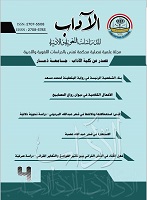Laqia (i.e. Meet) Verb in the Qur'anic Text between the Influence of Prefixes and Suffixes and the Reading Variances: A Morphological Study
DOI:
https://doi.org/10.53286/arts.v1i4.247Keywords:
'Laqia' Verb, Prefixes and Suffixes, Reading Variance, Morphological StudyAbstract
The Arabic verb 'laqia' (i.e. meet) is a transitive trilateral verb in which '' ya/ي'' letter comes as the root letter '' la/ل ''. . Through an analytical reading of the Qur'anic texts, the researcher's attention was drawn to the morphological structure of this type of verbs in Arabic. So the researcher has explored the occurrence of the''Laqia' verb in the Qur'anic texts as a trilateral, stem or derivative, whether as past present or imperative, showing the impact of the prefixes and suffixes on the structure of this verb, including morphological, semantic and functional changes. It was found out that these affixes change the basic form of this verb as ' fa'il' and 'yaf'al''(فَعِلَ/ يَفْعَلُ) into other verb forms. It was also found that the present tense verb prefixes have an influence on the structure of 'Laqia' verb due to their morphological values in terms of person, number, gender and tense as well as their morphological impact on the verb structure, specially in creating ''i'lal'' form of verb (defective form) through omitting the additional 'hamzah' in 'Laqia' present verb form. The researcher also pointed out the morphological values and significance of the suffixes related to subject in terms of person, number and gender as well as the morphological changes in the syllabic structure of the verb. Furthermore, the researcher shed light on the degree of conformity of such morphological phenomena with the regular rules in the light of different views of old and modern linguists, morphologists and old exegesis specialists. Besides, the research has showed that there are variances in uttering or pronouncing this verb in the Holy Qur'an texts by 'al-qurra'a', (i.e. the well-known readers of the Holy Qur'an), including the degree of the influence of such differences on the verb structure and function, specially it is known in Arabic linguistics that an addition in word structure entails an addition in its meaning. However, such variant readings can be attributed to the derivational root of al-liqa'a verb. Some 'qurra'a' regard this verb as the word root, some consider it as an aspect of 'alaq' and others as an aspect of 'walaq', but they all agree on the semantic meaning of such verb variances. This may be a characteristic of old Arabic dialects because Qur'an text never involves two different readings of words that create semantic ambiguity. The contexts of the Qur'anic texts are marked by conformity and its word forms change in accordance with such semantic differences. So this research has mainly investigated these linguistic phenomena of 'Laqia' verb as viewed by old and modern linguists, morphologists, al-qura'a and old exegesis specialists. This research paper has started with an introduction that includes its rationale, questions and methodology. This was followed by a detailed discussion of 'Laqia' verb along with the influence of prefixes and suffixes on this verb. The research has ended up with a conclusion that presents the main findingsDownloads
Downloads
Published
How to Cite
Issue
Section
License
Copyright (c) 2021 حمود ناصر علي نصار

This work is licensed under a Creative Commons Attribution 4.0 International License.
Copyright and Licensing
copyright is retained by the authors. Articles are licensed under an open access Creative Commons CC BY 4.0 license, meaning that anyone may download and read the paper for free. In addition, the article may be reused and quoted provided that the original published version is cited. These conditions allow for maximum use and exposure of the work.



